Labi-Hauz Ensemble
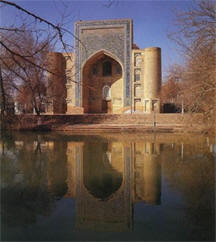 Labi-Hauz (translated from the Farsi "coast of the pond") - is the name of the locality and the architectural complex, which surrounds one of the few surviving ponds - "Hauz" in Bukhara. Prior to the establishment of Soviet goverment in Bukhara was a lot of these ponds, which served as sources of water for the residents of the city. But the pond has been infamous since they were the distributors of various infectious diseases. Therefore, for the most part were gradually drained Hauz during the 1920 - 30 years. Labi-Hauz survived because he is the center of the magnificent architectural ensemble, which was created during the XVI and XVII centuries, and which since then has not changed.
Labi-Hauz (translated from the Farsi "coast of the pond") - is the name of the locality and the architectural complex, which surrounds one of the few surviving ponds - "Hauz" in Bukhara. Prior to the establishment of Soviet goverment in Bukhara was a lot of these ponds, which served as sources of water for the residents of the city. But the pond has been infamous since they were the distributors of various infectious diseases. Therefore, for the most part were gradually drained Hauz during the 1920 - 30 years. Labi-Hauz survived because he is the center of the magnificent architectural ensemble, which was created during the XVI and XVII centuries, and which since then has not changed.
The ensemble consists of three monumental buildings: Kukeldash Madrassah - in the north, the largest in the city and two other religious buildings constructed Nadir Divan-Begi: Khanaka and Madrasah - the west and east.
Kukeldash Madrassah
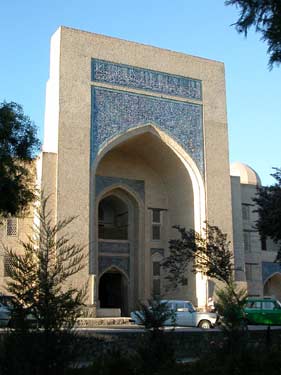 The word "Kukeldash" literally means "foster brother". In the hierarchy of power, has inherited from the Genghis Khan, the word "Kukeldash" was designated one of the most important court posts. Sponsor of Kukeldash Madrassah was very influential emir Kulbaba, which is kept at the title "Kukeldash" with several khans of Sheibanids dynasty. Emir Kulbaba Kukeldash helped Abdullah Khan II (1561-1598) - the most successful Khan of Sheibanids dynasty - at the time of his coming to power. According to the hallowed tradition, each new Khan raised on the canvas of white felt. The right to pull the four corners of the canvas with a given four most respected people in society. Emir Kulbaba was one of four built on the throne Abdullah Khan. In Bukhara Kukeldash Madrasah is largest by size (in terms of size - 80 x 60 feet, 130 residential facilities for students). This madrasa became a symbol of a strong state under the leadership of Abdullah Khan. Interior of Kukeldash Madrasah is an outstanding example of "white interior." Making the central portal made without glue or nails. The central portal is decorated with geometric patterns.
The word "Kukeldash" literally means "foster brother". In the hierarchy of power, has inherited from the Genghis Khan, the word "Kukeldash" was designated one of the most important court posts. Sponsor of Kukeldash Madrassah was very influential emir Kulbaba, which is kept at the title "Kukeldash" with several khans of Sheibanids dynasty. Emir Kulbaba Kukeldash helped Abdullah Khan II (1561-1598) - the most successful Khan of Sheibanids dynasty - at the time of his coming to power. According to the hallowed tradition, each new Khan raised on the canvas of white felt. The right to pull the four corners of the canvas with a given four most respected people in society. Emir Kulbaba was one of four built on the throne Abdullah Khan. In Bukhara Kukeldash Madrasah is largest by size (in terms of size - 80 x 60 feet, 130 residential facilities for students). This madrasa became a symbol of a strong state under the leadership of Abdullah Khan. Interior of Kukeldash Madrasah is an outstanding example of "white interior." Making the central portal made without glue or nails. The central portal is decorated with geometric patterns.
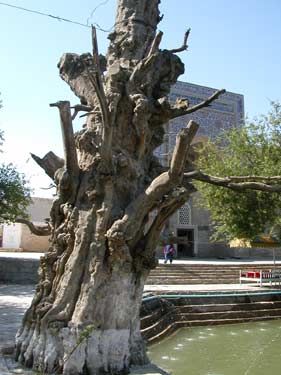 The story of Labi-Hauz ensemble is inextricably linked with the name of another important dignitary - Nadir Divan-Begi ("Divan-Begi" - is the title for the Khan's court). Nadir Divan-Begi served at Imamkuli Khan (1611-1642), the most strong ruler of the Ashtarkhanids (Janids) dynasty came to power in 1599. Ashtarkhanids were strangers to the powerful feudal lords in the field, close to gone from the scene of the ruling Sheibanids dynasty. Therefore Imamkuli Khan is only partially retained power in the state. In addition, adherence to the traditions of Islam in Ashtarkhanids was much smaller compared to the religious zeal of Sheibanids. These two important features characteristic of the reign of Ashtarkhanids, soon appeared in the landmark architectural trends.
The story of Labi-Hauz ensemble is inextricably linked with the name of another important dignitary - Nadir Divan-Begi ("Divan-Begi" - is the title for the Khan's court). Nadir Divan-Begi served at Imamkuli Khan (1611-1642), the most strong ruler of the Ashtarkhanids (Janids) dynasty came to power in 1599. Ashtarkhanids were strangers to the powerful feudal lords in the field, close to gone from the scene of the ruling Sheibanids dynasty. Therefore Imamkuli Khan is only partially retained power in the state. In addition, adherence to the traditions of Islam in Ashtarkhanids was much smaller compared to the religious zeal of Sheibanids. These two important features characteristic of the reign of Ashtarkhanids, soon appeared in the landmark architectural trends.
At that time Samarkand has demonstrated its independence from the central government a powerful feudal lord - Emir Bahadir Yalangtush. For several decades he ran the city. It contained a large army, and even made trips to the neighboring region, independently concluded peace treaties, and they wish to revoke them. With its huge financial resources, Yalangtush in 1619 began to build a grand Sherdor madrasah in Samarkand. The rich multicolored decoration madrassas, which includes an image of the sun, tigers, and antelopes, have revealed an innovative approach to design artistic expression unique to the Islamic culture in Central Asia.
Madrassah of Nadir Divan-Begi
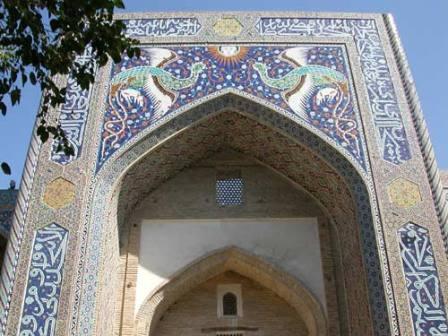 Three years later, following the example Yalangtush, Nadir Divan-Begi began construction of own Madrassah, the design of which was used images of birds, deer and humans, the sun. It is said that the building was originally built as a caravanserai (this, however, does not mean that the design of caravanserais of strict canons of Islam used the softer rules). But at the opening ceremony Imamkuli Khan suddenly announced that the building is a madrassa. So, that Nadir Divan-Begi had to change the design of the building, perched in its main facade loggias, portal and corner towers, and build on the second floor “hujras” (rooms for accommodation of students). However, the study room was never built.
Three years later, following the example Yalangtush, Nadir Divan-Begi began construction of own Madrassah, the design of which was used images of birds, deer and humans, the sun. It is said that the building was originally built as a caravanserai (this, however, does not mean that the design of caravanserais of strict canons of Islam used the softer rules). But at the opening ceremony Imamkuli Khan suddenly announced that the building is a madrassa. So, that Nadir Divan-Begi had to change the design of the building, perched in its main facade loggias, portal and corner towers, and build on the second floor “hujras” (rooms for accommodation of students). However, the study room was never built.
Hanaka Nadir Divan-Begi
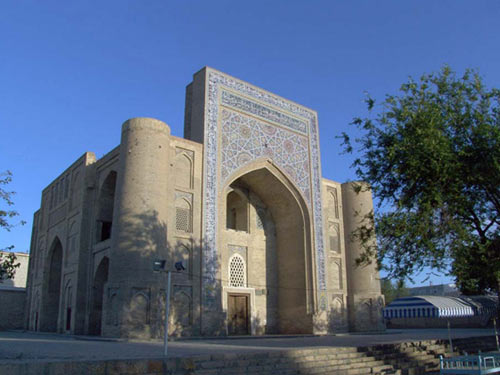 Hanaka is a large multichamber construction with a central domed hall (the side of the square - 11.2 m), cut shallow niches on the sides. In the corners and side walls of the building are inscribed hujra. The main portal of the building has a non-traditional elongated shape. In addition, there are two sides of the main portal. Hall ("zikr khona") has good acoustic properties. The decoration of the main entrance khanaka built until the decoration in Samarkand's SherDor madrasah, made a rather conservative, except for the retreat of the image colors. Along the edges of the main portal is decorated with epigraphic script. The front facade of the ends on both sides of slender towers, cut off at the height of the walls. Due to its location, as well as the presence of a large hall with good acoustics, Hanaka Nadir Divan-Begi for centuries been a center of cultural and religious life of Bukhara.
Hanaka is a large multichamber construction with a central domed hall (the side of the square - 11.2 m), cut shallow niches on the sides. In the corners and side walls of the building are inscribed hujra. The main portal of the building has a non-traditional elongated shape. In addition, there are two sides of the main portal. Hall ("zikr khona") has good acoustic properties. The decoration of the main entrance khanaka built until the decoration in Samarkand's SherDor madrasah, made a rather conservative, except for the retreat of the image colors. Along the edges of the main portal is decorated with epigraphic script. The front facade of the ends on both sides of slender towers, cut off at the height of the walls. Due to its location, as well as the presence of a large hall with good acoustics, Hanaka Nadir Divan-Begi for centuries been a center of cultural and religious life of Bukhara.
Hauz (Pond)
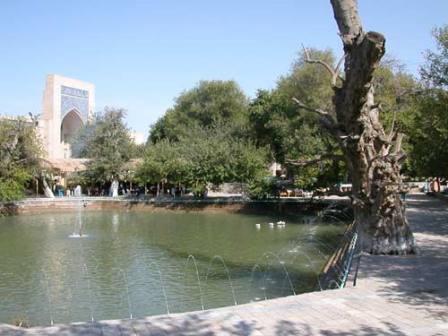 When Nadir Divan-Begi built hanaka, in place of the existing Hauz (Pond) had a large household, belonging to a Jewess widow. Nadir Divan-Begi has decided that this place is ideal for devices with pond Hanaka. He appealed to the widow of an offer to sell your yard for a good price. But the Jewess would not agree. Nadir Divan-Begi then took her to the Emir, being sure that he would force her to sell the house. But Imamkuli Khan handed consideration of this issue Board of muftis. Muslim jurists ruled that prohibits a court to take away the power of Jewish women, because they think Jews should enjoy the same rights as Muslims, because they pay tax "jizya" on the right to preserve their religion.
When Nadir Divan-Begi built hanaka, in place of the existing Hauz (Pond) had a large household, belonging to a Jewess widow. Nadir Divan-Begi has decided that this place is ideal for devices with pond Hanaka. He appealed to the widow of an offer to sell your yard for a good price. But the Jewess would not agree. Nadir Divan-Begi then took her to the Emir, being sure that he would force her to sell the house. But Imamkuli Khan handed consideration of this issue Board of muftis. Muslim jurists ruled that prohibits a court to take away the power of Jewish women, because they think Jews should enjoy the same rights as Muslims, because they pay tax "jizya" on the right to preserve their religion.
Divan-Begi had to limit the device small pond adjacent to the house where she lived a widow intractable. But the wily nobleman paved ditch for a new pond so that it passed directly under the walls of the house's widow, despite the fact that the construction of the ditch at this point cost him more. After a while, when the water began to wash away the foundation of the house, a Jewess came to the Divan-Begi, to appeal to his conscience. To which he replied, saying that its offer remains in force, and he now pays the cost of her house, only that it has agreed to sell it. The widow replied that she did not need the money, and she asks only one thing, namely, to replace her court she was given a plot of land with permission to build a Synagogue there. Divan-Begi agreed to the deal and handed o ver to the women, their land, who was in the neighborhood, now known as "Jewish." Soon, the first Synagogue was built in Bukhara and a great Hauz. Approximate date of its construction in 1620. Now Hauz - it is a rectangular pond (46*36 m), stretching from east to west. Its shores are decorated in a step-stone steps, made of massive blocks of yellow limestone.
Central Park, around a large pool of water still retains the magic of the past. Older people drink tea, sitting on the couch in the tea-house or play backgammon right in the water.
 Labi-Hauz (translated from the Farsi "coast of the pond") - is the name of the locality and the architectural complex, which surrounds one of the few surviving ponds - "Hauz" in Bukhara. Prior to the establishment of Soviet goverment in Bukhara was a lot of these ponds, which served as sources of water for the residents of the city. But the pond has been infamous since they were the distributors of various infectious diseases. Therefore, for the most part were gradually drained Hauz during the 1920 - 30 years. Labi-Hauz survived because he is the center of the magnificent architectural ensemble, which was created during the XVI and XVII centuries, and which since then has not changed.
Labi-Hauz (translated from the Farsi "coast of the pond") - is the name of the locality and the architectural complex, which surrounds one of the few surviving ponds - "Hauz" in Bukhara. Prior to the establishment of Soviet goverment in Bukhara was a lot of these ponds, which served as sources of water for the residents of the city. But the pond has been infamous since they were the distributors of various infectious diseases. Therefore, for the most part were gradually drained Hauz during the 1920 - 30 years. Labi-Hauz survived because he is the center of the magnificent architectural ensemble, which was created during the XVI and XVII centuries, and which since then has not changed. The word "Kukeldash" literally means "foster brother". In the hierarchy of power, has inherited from the Genghis Khan, the word "Kukeldash" was designated one of the most important court posts. Sponsor of Kukeldash Madrassah was very influential emir Kulbaba, which is kept at the title "Kukeldash" with several khans of Sheibanids dynasty. Emir Kulbaba Kukeldash helped Abdullah Khan II (1561-1598) - the most successful Khan of Sheibanids dynasty - at the time of his coming to power. According to the hallowed tradition, each new Khan raised on the canvas of white felt. The right to pull the four corners of the canvas with a given four most respected people in society. Emir Kulbaba was one of four built on the throne Abdullah Khan. In Bukhara Kukeldash Madrasah is largest by size (in terms of size - 80 x 60 feet, 130 residential facilities for students). This madrasa became a symbol of a strong state under the leadership of Abdullah Khan. Interior of Kukeldash Madrasah is an outstanding example of "white interior." Making the central portal made without glue or nails. The central portal is decorated with geometric patterns.
The word "Kukeldash" literally means "foster brother". In the hierarchy of power, has inherited from the Genghis Khan, the word "Kukeldash" was designated one of the most important court posts. Sponsor of Kukeldash Madrassah was very influential emir Kulbaba, which is kept at the title "Kukeldash" with several khans of Sheibanids dynasty. Emir Kulbaba Kukeldash helped Abdullah Khan II (1561-1598) - the most successful Khan of Sheibanids dynasty - at the time of his coming to power. According to the hallowed tradition, each new Khan raised on the canvas of white felt. The right to pull the four corners of the canvas with a given four most respected people in society. Emir Kulbaba was one of four built on the throne Abdullah Khan. In Bukhara Kukeldash Madrasah is largest by size (in terms of size - 80 x 60 feet, 130 residential facilities for students). This madrasa became a symbol of a strong state under the leadership of Abdullah Khan. Interior of Kukeldash Madrasah is an outstanding example of "white interior." Making the central portal made without glue or nails. The central portal is decorated with geometric patterns. The story of Labi-Hauz ensemble is inextricably linked with the name of another important dignitary - Nadir Divan-Begi ("Divan-Begi" - is the title for the Khan's court). Nadir Divan-Begi served at Imamkuli Khan (1611-1642), the most strong ruler of the Ashtarkhanids (Janids) dynasty came to power in 1599. Ashtarkhanids were strangers to the powerful feudal lords in the field, close to gone from the scene of the ruling Sheibanids dynasty. Therefore Imamkuli Khan is only partially retained power in the state. In addition, adherence to the traditions of Islam in Ashtarkhanids was much smaller compared to the religious zeal of Sheibanids. These two important features characteristic of the reign of Ashtarkhanids, soon appeared in the landmark architectural trends.
The story of Labi-Hauz ensemble is inextricably linked with the name of another important dignitary - Nadir Divan-Begi ("Divan-Begi" - is the title for the Khan's court). Nadir Divan-Begi served at Imamkuli Khan (1611-1642), the most strong ruler of the Ashtarkhanids (Janids) dynasty came to power in 1599. Ashtarkhanids were strangers to the powerful feudal lords in the field, close to gone from the scene of the ruling Sheibanids dynasty. Therefore Imamkuli Khan is only partially retained power in the state. In addition, adherence to the traditions of Islam in Ashtarkhanids was much smaller compared to the religious zeal of Sheibanids. These two important features characteristic of the reign of Ashtarkhanids, soon appeared in the landmark architectural trends. Three years later, following the example Yalangtush, Nadir Divan-Begi began construction of own Madrassah, the design of which was used images of birds, deer and humans, the sun. It is said that the building was originally built as a caravanserai (this, however, does not mean that the design of caravanserais of strict canons of Islam used the softer rules). But at the opening ceremony Imamkuli Khan suddenly announced that the building is a madrassa. So, that Nadir Divan-Begi had to change the design of the building, perched in its main facade loggias, portal and corner towers, and build on the second floor “hujras” (rooms for accommodation of students). However, the study room was never built.
Three years later, following the example Yalangtush, Nadir Divan-Begi began construction of own Madrassah, the design of which was used images of birds, deer and humans, the sun. It is said that the building was originally built as a caravanserai (this, however, does not mean that the design of caravanserais of strict canons of Islam used the softer rules). But at the opening ceremony Imamkuli Khan suddenly announced that the building is a madrassa. So, that Nadir Divan-Begi had to change the design of the building, perched in its main facade loggias, portal and corner towers, and build on the second floor “hujras” (rooms for accommodation of students). However, the study room was never built. Hanaka is a large multichamber construction with a central domed hall (the side of the square - 11.2 m), cut shallow niches on the sides. In the corners and side walls of the building are inscribed hujra. The main portal of the building has a non-traditional elongated shape. In addition, there are two sides of the main portal. Hall ("zikr khona") has good acoustic properties. The decoration of the main entrance khanaka built until the decoration in Samarkand's SherDor madrasah, made a rather conservative, except for the retreat of the image colors. Along the edges of the main portal is decorated with epigraphic script. The front facade of the ends on both sides of slender towers, cut off at the height of the walls. Due to its location, as well as the presence of a large hall with good acoustics, Hanaka Nadir Divan-Begi for centuries been a center of cultural and religious life of Bukhara.
Hanaka is a large multichamber construction with a central domed hall (the side of the square - 11.2 m), cut shallow niches on the sides. In the corners and side walls of the building are inscribed hujra. The main portal of the building has a non-traditional elongated shape. In addition, there are two sides of the main portal. Hall ("zikr khona") has good acoustic properties. The decoration of the main entrance khanaka built until the decoration in Samarkand's SherDor madrasah, made a rather conservative, except for the retreat of the image colors. Along the edges of the main portal is decorated with epigraphic script. The front facade of the ends on both sides of slender towers, cut off at the height of the walls. Due to its location, as well as the presence of a large hall with good acoustics, Hanaka Nadir Divan-Begi for centuries been a center of cultural and religious life of Bukhara. When Nadir Divan-Begi built hanaka, in place of the existing Hauz (Pond) had a large household, belonging to a Jewess widow. Nadir Divan-Begi has decided that this place is ideal for devices with pond Hanaka. He appealed to the widow of an offer to sell your yard for a good price. But the Jewess would not agree. Nadir Divan-Begi then took her to the Emir, being sure that he would force her to sell the house. But Imamkuli Khan handed consideration of this issue Board of muftis. Muslim jurists ruled that prohibits a court to take away the power of Jewish women, because they think Jews should enjoy the same rights as Muslims, because they pay tax "jizya" on the right to preserve their religion.
When Nadir Divan-Begi built hanaka, in place of the existing Hauz (Pond) had a large household, belonging to a Jewess widow. Nadir Divan-Begi has decided that this place is ideal for devices with pond Hanaka. He appealed to the widow of an offer to sell your yard for a good price. But the Jewess would not agree. Nadir Divan-Begi then took her to the Emir, being sure that he would force her to sell the house. But Imamkuli Khan handed consideration of this issue Board of muftis. Muslim jurists ruled that prohibits a court to take away the power of Jewish women, because they think Jews should enjoy the same rights as Muslims, because they pay tax "jizya" on the right to preserve their religion.














